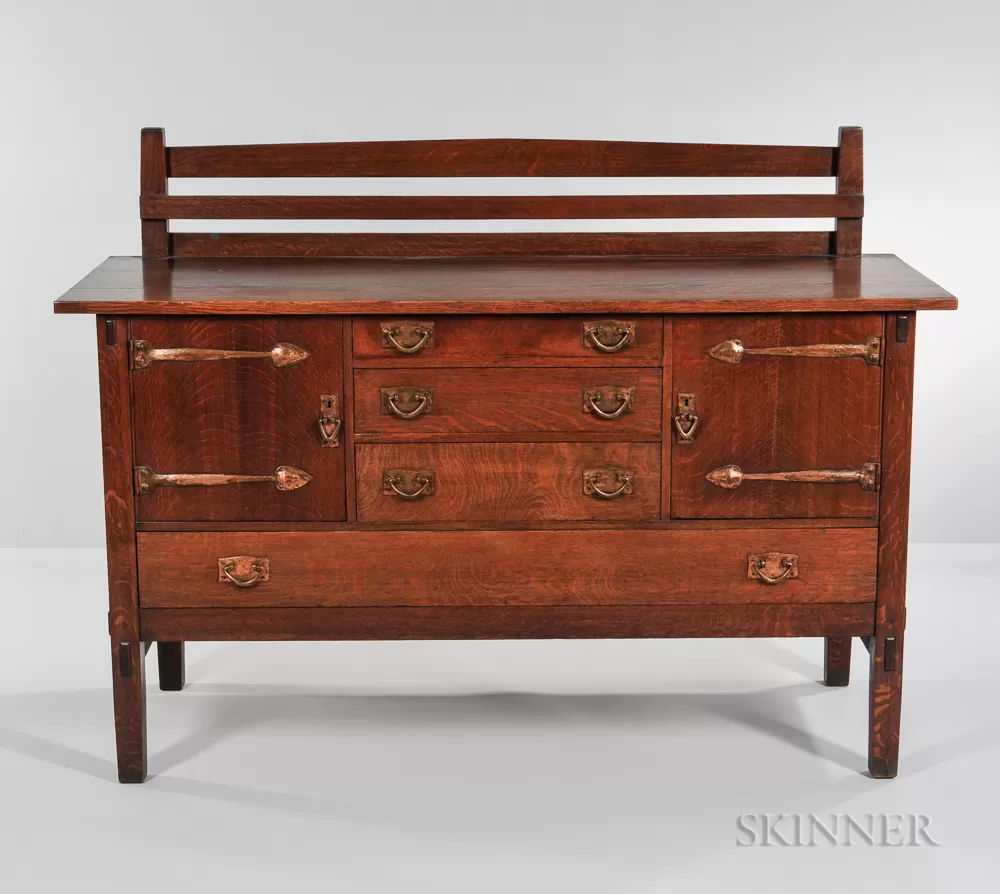A Sad Reunion
In 1976, as a young high school teacher, I visited the Saint Louis Art Museum. At the time I collected Golden Oak furniture: pressed back chairs, curved-glass secretaries, fancy trim headboards, and claw-footed Morris chairs. Looking back, I have but one distinct memory of the trip, that of a display of three Gustav Stickley pieces: a 66” sideboard, a flat-arm Morris chair, and a two-drawer library table with corbels flanking each leg.
While it was not a life-changing moment, I have long recalled being struck by the powerful design represented by these three pieces of Arts and Crafts furniture.
And last week I came across all three again.

In a Skinner’s auction catalog.
As if to remove any doubt, the description for each clearly stated:
“Property of the Saint Louis Art Museum, Sold to Benefit the Acquisition Fund.”
The sideboard had polished hardware and a seam separation, and the Morris chair had been refinished, so I reasoned that the museum was shedding their less than pristine examples of Stickley furniture. Curious, I went to their website, where, to their credit, the Decorative Arts and Design Department had pictured nearly all of their 660 items.

As it turns out, they were not just selling their three “lesser” examples of Gustav Stickley furniture.
They were selling their only three.
What they retained to represent American Arts and Crafts furniture was a Charles Rohlfs chair, a Greene and Greene desk, a Byrdcliffe chair, and a Frank Lloyd Wright chair.
No Stickley. No Limbert. No Roycroft.
So, I wondered, “Selling to acquire what?”
Which made me even more curious, so I picked up the phone and called the curator of the museum’s Decorative Arts Department. I got his assistant’s phone recording, left a message, along with my cell phone number, but no one has called me back.
Which is not surprising, given the sensitivity museums have when it comes to selling items which oftentimes had been donated to them by one of their patrons.
And so I called my close friend Lynne Poirier-Wilson, a former museum director and curator, to talk about deaccessioning.
“It is a sensitive issue,” Lynne agreed, “but every museum has the right to dispose of items that no longer fit within their mission. Very rarely will a museum accept a donation ‘in perpetuity.’ Donors are generally asked to sign a waiver giving the museum permission to do with them as they deem fit.”
“And,” she emphasized, “don’t think that museums take this decision lightly. The process has to go through a committee and, in many cases, to the board of directors, sometimes more than once before it can be approved.”

As Lynne went on to explain, museums most often will deaccession a piece for one of several reasons: storage costs, condition issues, expensive restoration, duplicate examples, their intent to acquire a more representative example, or if it no longer fits within their mission statement. And the proceeds from the sale of deaccessioned pieces must be utilized to purchase additional pieces for the collection, as opposed to paying the heating bill.
While I clearly understand what she was saying, I remain bothered by the distinct possibility that the Saint Louis Art Museum may never again have a piece of Gustav Stickley to catch the eye, the mind, and the imagination of another young visitor.
– Bruce Johnson
To view the Skinner auction catalog, please go to www.Skinnerinc.com/auctions/.
